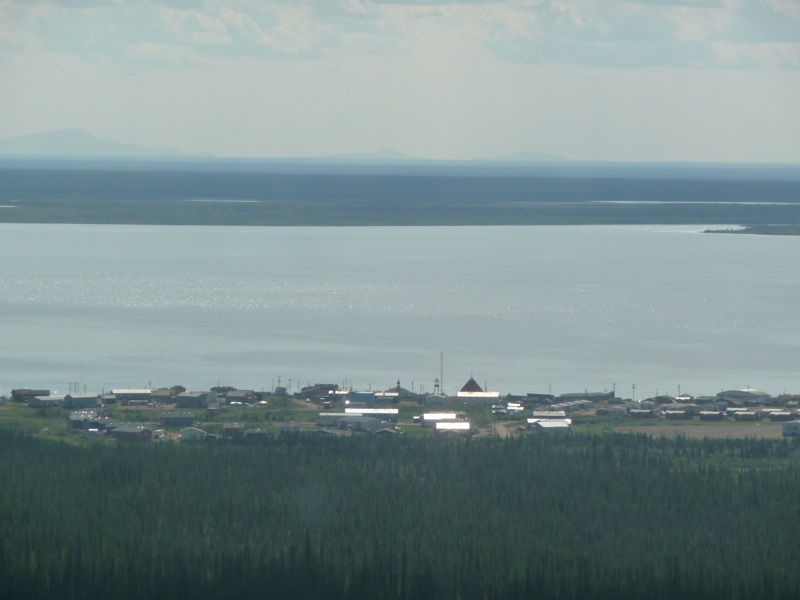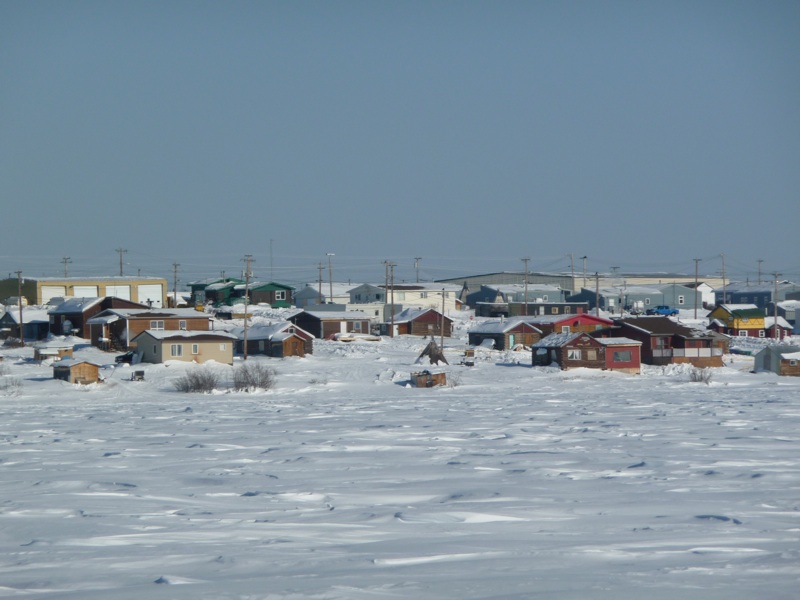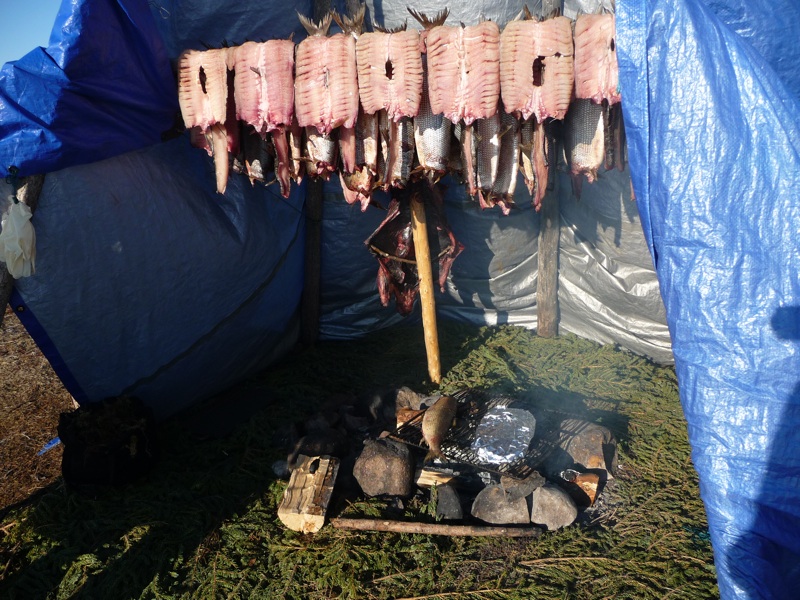Yáht’a Dágǫ́ht’e – All Year Round
We Sahtúgot’ı̨nę divide our yearly harvesting cycle into five seasons: Ɂı̨hbé (July and August), Xat’ą́ (late August to the end of October), Xae (November to February), Hı̨dóhxae (March and April) and Łuk’é (May and June). Seasonal activities are closely related to the land and the life of Sahtúgot’ı̨nę. In the past these activities were crucial for survival on the land – they remain important and alive to the present.
Ɂı̨hbé is a time when it is possible to travel by boat on the lake. It’s a time for gatherings and celebrations, as well as setting net for trout, hunting for moose and boreal caribou, and plant harvesting. In early Ɂı̨hbé, there’s a rush to check Ɂek’a Dúé (Fat Island) for barren-ground caribou bulls that stayed behind rather than following the cows – north to the calving grounds. The first berries to ripen during Ɂı̨hbé are raspberries and cloudberries, followed by blueberries and blackberries. Lastly, just before first frost, the tart cranberries are ruby red and ready to pluck.
Ɂı̨hbé in Délı̨nę
The lake is often governed by angry winds during Xat’ą́, but people travel to hunt and harvest whitefish nevertheless, and work to prepare for winter. In the past, people would travel in small family groups over the frozen land and thickening ice of the smaller lakes by the latter part of this season, setting up their winter camps near good fish lakes and trapping areas.
The cold, dark season of Xae was a very hard time with a constant struggle for survival. But this was also the time when people shared a lot of stories. The tradition of storytelling and teaching the younger generations through the stories remains central in the lives of Sahtúgot’ı̨nę today.
Days become longer during Hı̨dóhxae — caribou herds are travelling north to their calving grounds and if they’re close enough, it’s a good time to harvest the fat cows and the bulls that follow behind. This season before the flies and mosquitoes come out is ideal for bleaching hides. Today jigging for fish through the ice is especially popular during these months.
Hı̨dóhxae in Délı̨nę
During the early part of Łuk’é, the rivers start to break up and people travel on the lake ice to spring fish camps to set nets for whitefish, and to harvest ducks and geese migrating northward, and occasional straggling barrenground caribou bulls.
Making dry fish and dry beaver during Łuk’é
The climate is rapidly changing now. The prevailing winds are changing, and the weather is less predictable. Sahtúgot’ı̨nę are increasingly aware of new challenges in travelling safely on the land and water. The elders have emphasized the importance of spending a lot of time learning on the land in order to be able to adapt well.
Gúlú Agot’i T’á Kǝ Gotsúhɂá Gha — Learning About Changes
The people camped at the location known as Délı̨nę (Where the Water Flows) during the winters of 1825 to 1827 made an early encounter with Europeans when explorer Sir John Franklin and his crew used that area as a staging area and winter quarters.
Eventually with the arrival of the fur trade and Roman Catholic missionaries, and especially the installation of the radium/uranium mine at Port Radium on the east shore of Sahtú in 1930, Sahtúgot’ı̨nę language, culture and way of life evolved and adapted. Residential schools and more recently day schools brought a new way of learning and thinking that excluded our stories and language.
Délı̨nę became a permanent settlement relatively recently, around half a century ago. Now our way of life is marked by change and continuity as we seek ways of surviving as Dene in a changing world. As our world changes, so do the conditions for understanding our language.
The Sahtúgot’ı̨nę language is at a critical threshold in that language use and transmission has declined over the past twenty years, and the language could easily cease to be spoken in a short time. At this time, the language is still regularly heard in the community. Variability continues to exist in the language, based in part on the different places of origin of different families.
There is also an understanding in the community of what is happening in terms of declining language transmission, and a strong desire to reverse this. Sahtúgot’ı̨nę are looking for ways to strengthen their language, stories, songs and way of life and the land as they make the transition to self-governance.
Song
At all times, Dene people have found many occasions to sing together as well as use song more privately as a vehicle for expressing feelings. Traditionally, people would gather in late spring or summer after a year of travelling in smaller family groups. During these gatherings, people would dance shoulder-to-shoulder in a great circle around a fire, while singing songs known from way back or inventing songs on the spur of the moment. Since there was no drum used during a Tea Dance (or į́lı̨wá) the regular foot movements served to mark a steady beat. Tea Dance has evolved differently in the region but nowadays, only a few Tea Dance songs are danced at the end of a Drum Dance.
The Drum Dance has become one the most important community events since it is featured within many contexts, year round, such as religious feasts (Christmas or Easter), but also weddings, funerals, political meetings, and multi-community gatherings of all kinds. Several drummers sing in unison while people dance in a circle in front of them. Songs sung during a Drum Dance come from prophets, or spiritual leaders, who have received them during visions or dreams along with messages to pass on to their people. The Prayer songs that precede a Drum Dance can also be heard in other contexts, such as important meetings, church events or in private homes. These as well as the other spiritual songs that people dance inspire utmost respect no matter the context.
Edzi, a men’s team gambling-guessing game, constitutes another community event during which drumming, singing and vocalizing play an important role. Two teams face each other. One man from one team has to guess in which hand the other team’s players have hidden a token. Then roles are reversed, and this happens several times before one team is completely eliminated. Before each set, team songs are sung while betting takes place. During the guessing period, a number of drummers beat a steady rhythm, while loudly vocalizing, at the same time supporting their own team and distracting the other. Although played intensely, much teasing and laughter occurs throughout. This is also a great game to play when a group visits from another community. Nowadays, regional tournaments are organized year-round.
In a more private context, ets’ula, often translated in English as “love-songs”, serve to express personal or intimate feelings, such as singing about the beauty of the land, thinking about someone recently departed but also when feeling contented or lonesome while travelling, by canoe or over land. Some texts for these songs are fixed by tradition but a melody might be re-used with different words, adjusting to context and the creativity of the singer.





